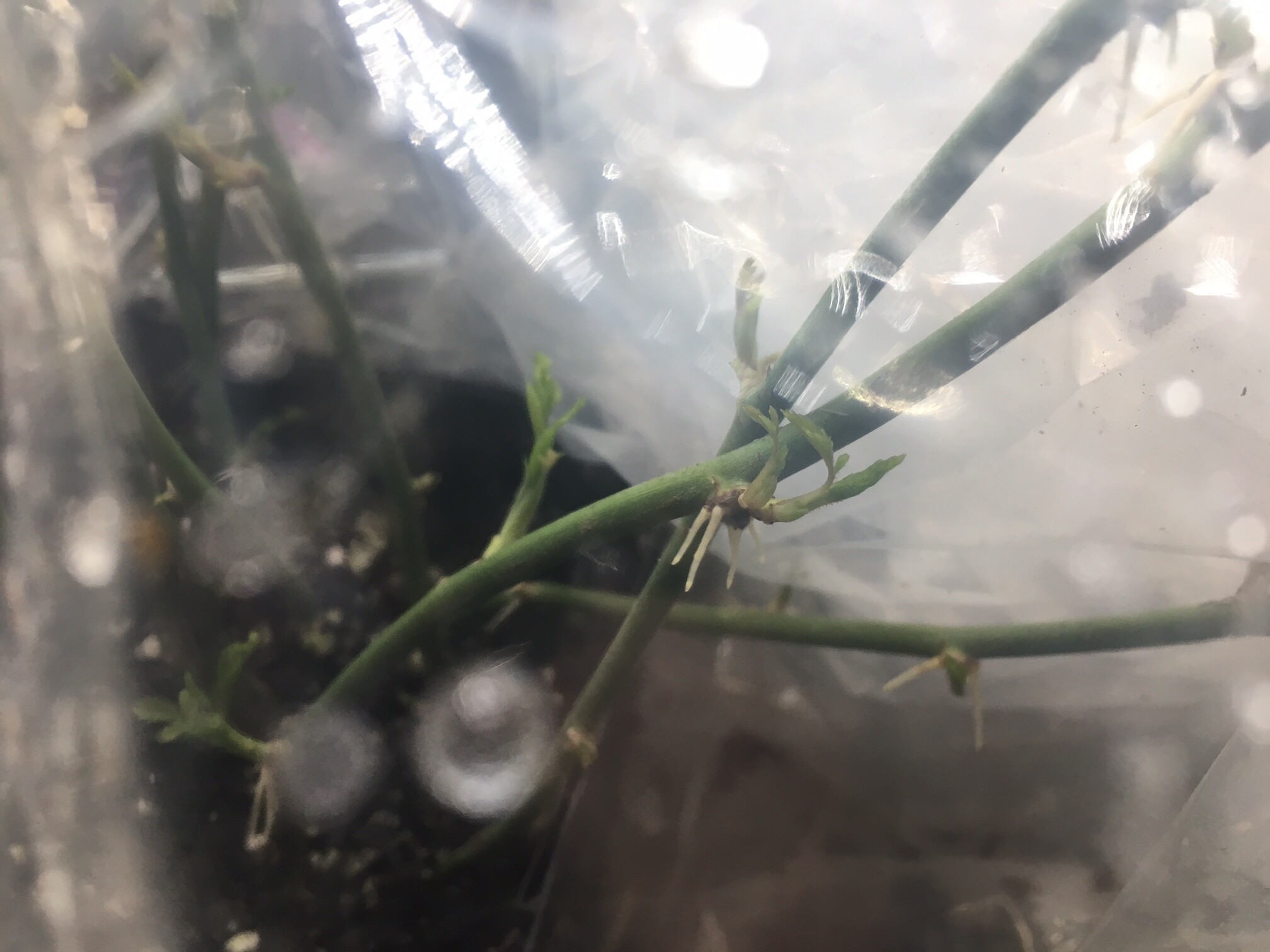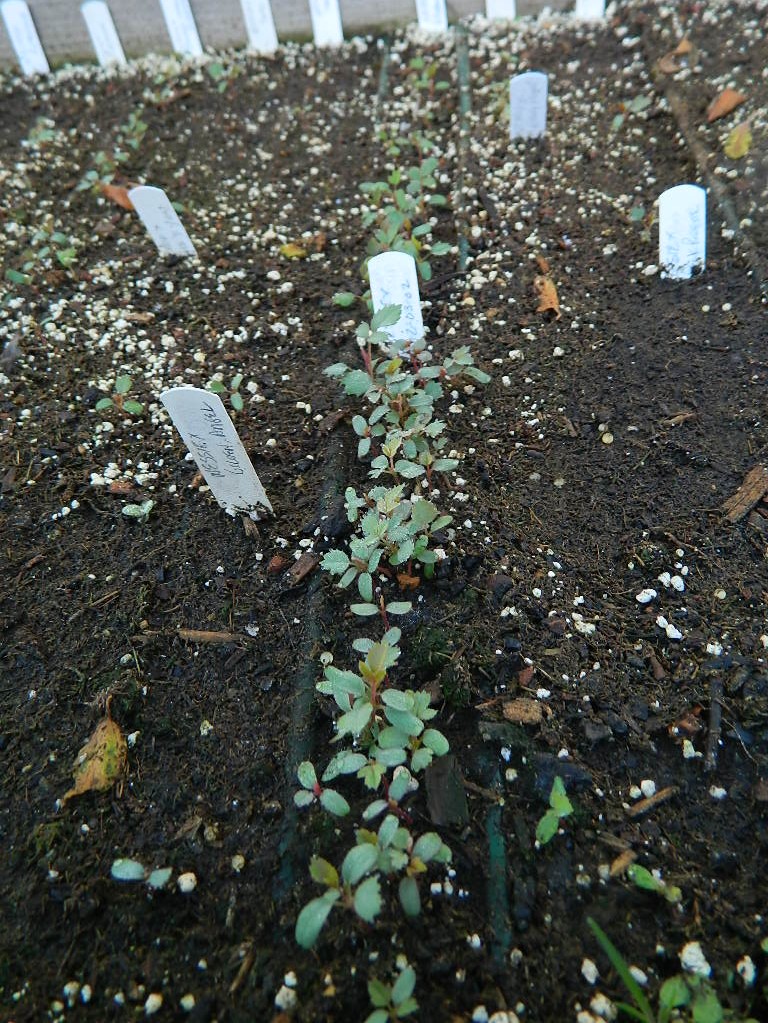Helping with the rose rosette disease USDA SCRI grant, I’m helping generate and share some R. setigera hybrids. There is one thornless seedling of R. setigera ‘Serena’ x R. wichurana ‘Basye’s Thornless’ that is particularly vigorous and ground hugging like ‘Basye’s Thornless’. There was a long cane that got broken off this spring and I cut it into several hardwood cuttings and potted it up just over a week ago. There are roots coming out by the swelling axillary buds above the soil!! I haven’t rooted hardwoods of ‘Basye’s Thornless’ before. I suppose the ease of rooting comes from BT. I’ll hopefully get a lot of this seedling propagated and can share it with those interested. I have to double check if I counted its chromosomes specifically, but I’d suspect it would be diploid as both its parents are. It hasn’t bloomed yet, but if it behaves like other R. setigera hybrids, it should be male sterile and female fertile and more readily accept pollen from diploid Synstylae derivatives. If this interests you, let me know and I’ll get a list going and will hopefully be able to ship these out later this spring/summer.

Hi David,
Tangentially to your topic, I wanted to update you publicly on my crosses with Serena this year.
Because of your observation that Serena is female only would mostly just accept pollen from Synstylae roses, I was surprised to see that mine set tons of OP hips full of seeds. I couldn’t think of any Synstylae roses nearby. Also it set seeds from the pollen of a couple modern tetraploids. And Smoothie and Darlow’s Enigma, which would be expected.
What was interesting is that there was zero germination from hundreds of open-pollinated seeds, while the Serena x Darlows Enigma seemed to germinate readily. There were a handful of germinations from Serena x Smoothie (I think three). Zero from Serena x FIVI3, a tetraploid seedling of mine, and exactly one seedling of Serena x (redacted, a modern hardy rebloomer from a friend that is likely tetraploid and not particularly Synstylaeish). That last seedling is showing reddish leaves in contrast to the x Darlows, so I’m somewhat optimistic that it is a true cross.
My stratification methods were experimental this year, and I’m not confident that there was not some other variable coming into play. Therefore not too much can be concluded from these results…it’s just that they are interesting.
I would love to try your new seedling. I’ll probably have to keep it in a pot, but it will be a lot less painful to work with than Grouse.
You have contributed so much to the rose breeding world. Thank you.
Joe
Hi David, that one looks very interesting! If you have enough later on, I would love to be on the list. You are expecting female fertility from this seedling? Right? Thank you!
Jim
I’m not familiar with Basye’s thornless wichurana, but that should provide some very interesting and valuable material. And if it roots as willingly as it appears… (I actually find that my R.s.serena roots pretty readily. It and my chinas are among the few that I can consistently root.)
As an aside, is the preferred method for doubling chromosomes now oryzalin, trifluralin, or still colchicine? I’m not sure what the relative efficacy/hazards of the various chemicals are. Oryzalin-induced chromosome doubling in Rosa and its effect on plant morphology and pollen viability - PubMed
I’ll take good care of these cuttings and share them when they are ready. The dinitroaniline herbicides (oryzalin and Trifluralin) seem to be the standard for doubling now because of lower concentrations needed to double plants, plant microtubules being more sensitive to them than colchicine, and them being less toxic to animals. Most people use oryzalin, but since I have trifluralin, I’ve been using it instead over the years. Perhaps pressurized nitrous oxide will become the standard for safety??? I wish I had the equipment to try it.
David,
If you have enough I’d love to work with your R. setigera ‘Serena’ x R. wichurana 'Basye’s Thornless seedling as well. Thank you!
HI Everyone!
I had some trouble with these cuttings (my own fault), but will stick a whole bunch very soon. The mother plants are growing gangbusters. They are SOOO vigorous sending out canes growing what seems like inches each day.
I would be interested in cuttings and/or rooted cuttings of this specimen, for use as breeding material. Thanks for your consideration. Please feel free to PM me with details when you have them available. Let me know if I can reimburse shipping or else “trade” something from my own stock.
Thanks!
I would be curious to know how this plant works as a breeder when the time comes, David. I am assuming your plant will be female fertile, but do you expect the seedlings will be monoecious?
Hi Phillip!!
There are some seedlings I’m potting up from it lately. The seeds germinate well. Unfortunately, this past summer either black spot or cercospora (I suspect cercospora) really marred the foliage. It looks a bit different on this rose, whichever it is. It has a sibling just a bit more resistant than the one of the cuttings pictured, but still it problematic. In crosses with R. setigera and polyanthas the first generation previously was all male sterile and female fertile. Crossing polyantha pollen on them led to half male sterile female fertile / female and male fertile. I suspect the same will happen here too (instead of a polyantha dad for the first generation there was a diploid thornless R. wichurana). There is a dominant male sterile allele it seems of a key gender gene from female R. setigera that trumps whatever allele or form of the gene is other species that leads to fertility. I forgot if I double checked and looked at the pollen of this hybrid last summer under the microscope to see if it was aborted and confirm. I will see if I have some records of it and if not do so next year for curiosity sake. I put polyantha pollen on the blooms of this R. setigera ‘Serena’ x R. wichurana ‘Basye’s Thornless’ hybrid and that is what is germinating now (there are two thornless roses that go by ‘Bayse’s Thornless’, this is the low prostrate diploid one that seems fully R. wichurana and not the one with R. carolina in it).
Hi David. The other “Basye’s Thornless” with Wichurana in it is likely what Sequoia sold as Basye’s Thornless Wichurana. I grew that for quite a few years from Ralph, and lost it. I asked him about it one fall and he said he would have to root some. The following April, when we were all up there for the opening of his memorial garden, I stood in line waiting to shake his hand. He saw me and kept looking my way as he greeted other visitors. When it was my turn, he grabbed my hand and yanked me down close to where he was seated. “Remember that thornless wich you asked me about a while ago? I rooted it and have a couple of plants to give you back at the nursery. Remind me when we get over there!” Pretty great memory for a gentleman firmly in his nineties at that point! I passed that one around to several people a few years ago as I had run out of room (again!). I hope you get something fun from it! Good luck!
Kim, I really wish you would take all of your anecdotes and stories and compile them into one volume. You could write quite the memory of Ralph Moore alone. I for one would purchase that book. …Errr… if the price were reasonable. ![]()
David, I’m sorry to hear that that seedling hasn’t proven itself a little more resistant. What has been your general experience with the health of your setigera seedlings? I have R.s.serena, and have noticed that it is somewhat susceptible to BS (or something of that nature). Nothing horrible, but I could imagine that offspring might have weakened resistance.
Hi Philip,
There is a form of rust that has come through in recent years that seems to infect the R. setigera plants here pretty strongly (foliage, hips, even stems). The hybrids tend not to get that, so maybe that susceptibility is recessive for this form of rust and modern or other roses tend to be resistant. Otherwise, for black spot R. setigera seems to generally be better than average as the species and the hybrids with modern roses tend to range across the board. It seems to really elevate resistance to stronger levels like in the really good landscape roses of today it’ll take another generation or two. I have a number of R. setigera x polyantha hybrids near the R. setigera x R. wichuriana hybrids and the polyantha hybrids seem much healthier holding foliage better. I’m not sure what is unique about the combination of R. setigera with R. wichurana that leads to stronger defoliation. I wonder with the hybrids being so prostrate close to the ground impacts them with moisture and more susceptibility. The R. wichurana x polyantha hybrids are very clean though (bit of mildew when conditions are right) and those are pretty prostrate though.
I’m hoping to get the chance to cross its offspring with some of my stronger Kordes roses, so that might give more strength to the stems. We’ll see if the wichuriana in Kordes hurts.
Have you tried any of the other more esoteric synstylae? Something from the Brunonianae for instance?
Something Brunonianae? You mean like Nessie? 'Nessie' Rose It is definitely seed and pollen fertile. The seeds are quite small but they are potent!

Well, as a matter of fact…
(Kim, you are going to be overrun with those monsters.) ![]()